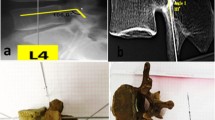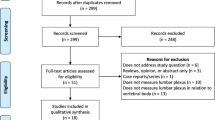Abstract
The aim was to evaluate the reliability of Tuffier’s line usually used as sole method to identify lumbar spinous process for a correct needle placement. Fifty-eight cadaver specimens were placed in a lateral position and a flexion in the lumbar spine performed to achieve a neutralization of the lumbar lordosis. The iliac crests were palpated and the lumbar spinous process marked on the intercristal line with a pin; all specimens were dissected and the marked spinous process documented. The center of the L4 spinous process was hit in 24 male (41.38%) and 10 female (17.24%) specimens. In only two female specimens (3.45%), the upper vertebra was reached; a pin placed in L3 was not found in male cadavers. The inferior edge of the L4 spinous process was hit in male 4 times (6.90%) and in female cadavers 12 times (20.69%). In the fifth lumbar spinous process, pins were placed five times in female cadavers (8.62%) and in only one male cadaveric specimen (3.72%). In conclusion, the accuracy of the focused lumbar spinous process depends on the right bedding and the orientation of the given landmarks, so Tuffier’s line stays the most important tool for anesthetists if palpation is performed very precisely.



Similar content being viewed by others
References
Broadbent CR, Maxwell WB, Ferrie R, Wilson DJ, Gawne-Cain M, Russell R (2000) Ability of anaesthetists to identify a marked lumbar interspace. Anaesthesia 55:1122–1126
Chakraverty R, Pynsent P, Isaacs K (2007) Which spinal levels are identified by palpation of the iliac crests and the posterior superior iliac spines? J Anat 210:232–236
Ellis H, Feldman S (1977) Anatomy for anaesthetists, 3rd edn. Blackwell Scientific Publications, Oxford, pp 122–124
Furness G, Reilly MP, Kuchi S (2002) An evaluation of ultrasound imaging for identification of lumbar intervertebral level. Anaesthesia 57:277–280
Gordh T (1979) Spinal anaesthesia. In: Eriksson E (ed) Illustrated handbook in local anaesthesia. Llyod-Luke, London, pp 116–124
Hollinshead H (1964) Anatomy for surgeons, Vol .3, back and limbs. Holber Medical Division, Harper & Row, New York, pp 120–122
Jacoby GW (1895) Lumbar puncture of the subarachnoid space. N Y Med J 62:813–818
Kettani A, Tachinante R, Tazi A (2006) Evaluation of the iliac crest as anatomic landmark for spinal anaesthesia in pregnant women. Ann Fr Anesth Reanim 25:501–504
Kim JT, Bahk JH, Sung J (2003) Influence of age and sex on the position of the conus medullaris and Tuffier’s line in adults. Anesthesiology 99:1359–1363
MacGibbon B, Farfan HF (1979) A radiologic survey of various configurations of the lumbar spine. Spine 4:258–266
Render CA (1996) The reproducibility of the iliac crest as a marker of lumbar spine level. Anaesthesia 51:1070–1071
Shiraishi N, Matsumura G (2006) Establishing intercrestal line by posture: a radiographic evaluation. Okajimas Folia Anat Jpn 82(4):139–146
Santiago FR, Milena GL, Herrera RO, Romero PA, Plazas PG (2001) Morphometry of the lower lumbar vertebrae in patients with and without low back pain. Eur Spine J 10:228–233
Snell R, Katz J (1988) Clinical anatomy for anaesthesiologists, 1st edn. Appleton, Norwalk, pp 134–135
Snider KT, Kribs JW, Snider EJ, Degenhardt BF, Bukowski A, Johnson JC (2008) Reliability of Tuffier’s line as an anatomic landmark. Spine 33:161–165
Thiel W (1992) The preservation of the whole corpse with natural color. Ann Anat 174:185–195
Tuffier T (1900) Anesthésie médullaire chirurgicale par injection sous-arachnoidienne lombaire de cocaïne, technique et résultats. Sem Medicale 20:167–169
Van Gessel EF, Forster A, Gamulin Z (1993) Continuous spinal anesthesia: where do spinal catheters go? Anesth Analg 76:1004–1007
Williams PL (1999) Gray’s anatomy, 38th edn. Churchill Livingstone, London, pp 526–528
Author information
Authors and Affiliations
Corresponding author
Rights and permissions
About this article
Cite this article
Windisch, G., Ulz, H. & Feigl, G. Reliability of Tuffier’s line evaluated on cadaver specimens. Surg Radiol Anat 31, 627–630 (2009). https://doi.org/10.1007/s00276-009-0493-z
Received:
Accepted:
Published:
Issue Date:
DOI: https://doi.org/10.1007/s00276-009-0493-z




